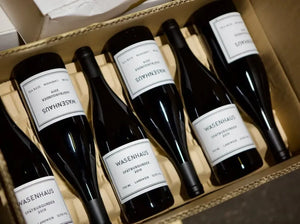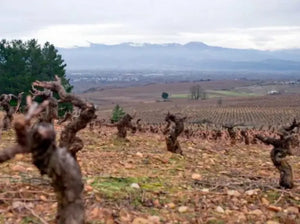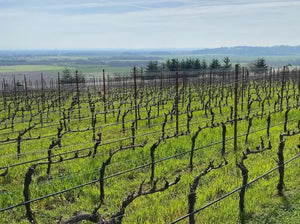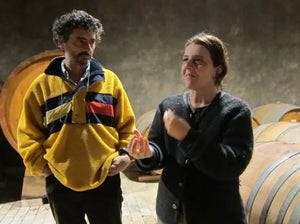Blog » Burgundian
-
A Star in Central Portugal: Textura
The Dão is unique. Resistant to the Atlantic influence that characterizes so many of Portugal’s wine regions, this little enclave of viticulture exists to defy expectations. One of the projects highlighting the possibilities within the region is Textura. Beginning in 2018, the project pulls from over 20 hectares of organic vineyards within two subregions: Castendo and Serra da Estrela.
The approach to winemaking at Textura shows a commitment to low-intervention practices that have served winemaker Luis Seabra well. His consultation and guidance have left their mark on Textura’s lineup, with “Burgundian” being a term used to describe the wines. Especially evident in wines like Textura da Estrela, judicious use of oak, a pinch of reduction, and natural acidity integrate into an enticing, racy wine that pairs with a huge range of cuisines.
What’s distinctly not “Burgundian” here are the grapes. While varieties like Encruzado, Arinto, and Gouveio don’t have the international recognition of Chardonnay, they deliver vibrant wines full of character.
In Dão, like so many regions of Portugal, the blend is key. The wines here are all about harmony. The floral and tea aromas, citrus, and orchard fruits like pear all emerge from the modest veil of reduction in wines like Pretexto, while the deep well of concentration present in Pura gives the impression of a wine worth waiting for, though it is singing at present.
No country has jolted our team over the last year like Portugal. Wines like those of Textura have the salinity and mineral punctuation with perfectly judged ripeness of fruit that has simply thrilled us. -
Anything but Ordinaire: Wasenhaus Spatburgunder
The hunt for German Pinot Noir producers who get it is a never-ending pursuit. Much of the point-chasing efforts from estates in Baden (Pinot Noir territory) are overly masked through excessive oak, extraction, and out-of-whack ripeness seemingly intended to elicit oohs and ahs from tasters as if they had finally made that Burgundy-beater. Any German producer intent on outshowing Burgundy would be better suited in another line of work.
Today's afternoon offer is exciting for a couple of different reasons. First, Alexander Götze and Christoph Wolber have spent over a decade working at Burgundian domaines like Leflaive, De Montille, Pierre Morey, and Comte Armand. Secondly, I have fond memories of spending time with Alex during my year-long stint in Beaune. His goal was always to return to Germany and produce Pinot Noir that followed the sensibilities that the Côte d'Or naturally transmitted.
Wasenhaus is Pinot Noir at its most ethereal. For me, the entry-level bottling, Grand Ordinaire, is the highlight of the lineup. The delicacy and levity here brought an up-front drinkability and ease that's undeniably delicious and equally brilliant. No doubt, the duo's experience in Burgundy imparted an important lesson: That great wine is made in the vineyard and raised with a soft touch in the cellar.
Much of the elegance in the Wasenhaus range can be attributed to working with vineyards with a higher content of limestone and sand versus the heavier clay soils that are more common throughout Baden. As you can imagine, those with an eye toward grace above power will choose their sites wisely.
The Spätburgunder ferments with 90% destemmed fruit and 10% whole clusters. Aging takes place in neutral barrel for one year, followed by six months in stainless steel. This switch really benefits the wine as it holds in those more crunchy and bright red berry fruit characteristics. The lingering finish with sweet brown spices and savory tones is persistent, especially given the humble price point.
I'm always up for tasting German Pinot Noir, but I rarely find wines that pull me in like red Burgundy. For Wasenhaus, it's the effortless sensibility and focus on terroir that shines the brightest. -
Spanish Mic Drop: Raul Perez Atalier
It's hard to comprehend how one producer, like Raul Perez, can redefine the Spanish white wine category. His most monumental wine is Sketch, an Albariño sourced from a 0.5-hectare parcel of old vines in Rias Baixas, priced at $100-plus per bottle. It's worth its weight in gold, but upon release, rumors swirled that his other Albariño was going to be the proverbial mic drop moment for the variety.
Our go-to Atalier bottling, "A Cruz das Animas" comes from two parcels of Albariño vines in the Cambados area of the Salnés Valley, located in the southern portion of Spain's northwest tip. And today, we're adding "La Encrucijada" from Atalier's oldest and most sea-adjacent vines, which sees extended aging in barrel (About 14 months) on its fine lees before bottling. Raul's greatest influence is white Burgundy, and he takes every step possible to preserve Albariño's cut and delineation iwhile also pushing for maximum ripeness and flavor development.
The key steps are harvesting very late and then blocking malolactic fermentation, which allows for superb ripeness but eliminates the more viscous and creamy elements of Albariño that don't appeal to Raul. Aging is in older French foudre, which preserves tension and softens texture. Perez redefines what a mineral-driven Spanish white wine is capable of, showing the same depth and nuance I expect from Chablis and Côte de Beaune Chardonnay. Simply put, his Atalier over-delivers. -
New Venture in Willamette: Walter Scott Aligoté
The pinnacle of the range from Erica Landon and Ken Pahlow of Walter Scott rests with their X Novo and Seven Springs Vineyard Chardonnays, though the Pinot Noirs are also among the best in the U.S.—the 2019 Bacocho Pinot Noir is a favorite. These are Grand Cru-level expressions of Willamette’s Eola-Amity Hills!
You'll also find a new addition to the lineup. The Williams family has been farming X Novo Vineyard with organic practices for over a decade. It’s now considered one of the most renowned sites in the valley. In 2018, they acquired an additional 40 acres neighboring X Novo, including the X Saxa Vineyard, originally planted to Riesling. They quickly grafted the vines over to Chardonnay and Aligoté. For a region that’s largely inspired by Burgundy, it’s still quite rare to find Aligoté in Oregon.
The X Saxa Aligôte and X Novo Chardonnay are reference points for Walter Scott and their touchtone finesse. Pahlow's harvests alongside Dominique Lafon in Meursault left their mark, as his white wines elicit a similar noble reduction and filigree. Compared to the Chardonnays, the Aligoté has even more alluring aromatics and opulent notes of pear blossom and green melon on the palate. If Aligôte in Burgundy can often verge on lean and pleasing, then X Saxa challenges that notion with its fruit-forward nature, tension, and seamless texture. -
Giovanna's Chianti: Le Boncie
When I have the opportunity to prove that Chianti Classico can show grace and pristine fruit quality akin to Red Burgundy, I use Giovanna Morganti's Le Boncie as my first example. I implore you to trust this will be your moment of clarity for Sangiovese.
Importer Neal Rosenthal's Montevertine is a benchmark for the region, but his other discovery, Le Trame, better illustrates Sangiovese's sometimes elusive, fruit-forward profile and silken tannins. Also consider Chiesamonti, which comes from a one-hectare parcel in Castelnuovo Berardenga. The stonier soils here result in a wine with brighter red fruits and a long saline finish (Differing from Giovanna's other wines that exhibit more fleshy characteristics). These two Chiantis are all class.
Giovanna farms her five hectares using organic and biodynamic principles. I could go down the rabbit hole on farming, fermentation, and aging specifics, but I'd like to cut this one short and say: This is a profound wine that's a joy to drink. I've lost count of the number of times I've used this bottling to convince friends that Sangiovese can be fun, approachable, and deadly serious. Below is a photo from my 2017 visit and the gorgeous color of the Stockinger barrel sample that had me in love.
.svg?v=162776257677185172071724397232)







